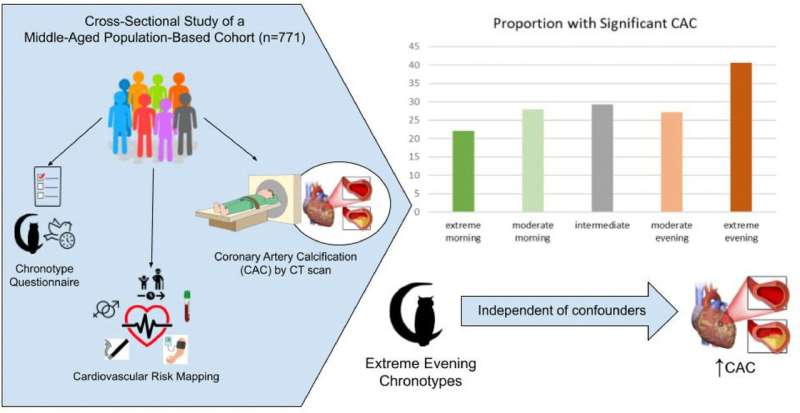This article has been reviewed according to Science X's editorial process and policies. Editors have highlighted the following attributes while ensuring the content's credibility:
fact-checked
peer-reviewed publication
proofread
Artery calcification more common in night owls, shows study

Artery calcification is almost twice as common in night owls compared to early birds, according to a study from the University of Gothenburg, Sweden. Circadian rhythm appears to be particularly important for the heart and blood vessels during the early stages of the disease.
Artery calcification, or atherosclerosis as it is also known, involves fatty deposits accumulating on the inside of the arteries, making it harder for blood to pass through. The disease develops over a very long period of time, and is not noticed until it leads to angina, blood clots, heart attack, or stroke.
Previous research has shown that people with late-night habits have an increased risk of cardiovascular disease, but this is the first study to show how circadian rhythm specifically affects artery calcification.
Coronary artery calcification
The study, which has been published in the journal Sleep Medicine, involved 771 men and women aged between 50 and 64, all of whom are part of the larger population study SCAPIS.
The degree of artery calcification in the heart's coronary arteries was examined using computer tomography. Participants themselves indicated their so-called chronotype on a five-point scale: extreme morning type, morning type to some extent, neither morning nor evening type, evening type to some extent, or extreme evening type.
Of the 771 participants, 144 identified as extreme morning types, and 128 as extreme evening types. Among the group who were most alert in the morning, 22.2% had pronounced artery calcification—the lowest proportion of all five chronotypes. The extreme evening type group had the highest incidence of severe coronary artery calcification, at 40.6%.
First author of the study is Mio Kobayashi Frisk, a doctoral student at Sahlgrenska Academy, University of Gothenburg. "Our results indicate that the extreme evening chronotype may be linked not only to poorer cardiovascular health in general, but also more specifically to coronary artery calcification and to the process that leads to artery calcification," Frisk says.
Preventive treatment
The statistical analysis took into account a range of other factors that can affect the risk of artery calcification, including blood pressure, blood lipids, weight, physical activity, stress level, sleep, and smoking.
"As well as the previously known factors, the individual circadian rhythm also appears to be an important risk factor for artery calcification. We interpret our results as indicating that circadian rhythm is more significant early in the disease process. It should therefore be taken into account in the preventive treatment of cardiovascular diseases in particular," says Ding Zou, last author of the study.
Self-reported chronotype
Those who had experienced a heart attack were excluded from the study, meaning that the study participants were healthier than the general population. Another weakness identified by the researchers is that participants themselves provided their chronotype.
Each chronotype can be said to have an average time when half of the night's sleep has passed. In a previous study on the same population, though not necessarily the same individuals, this time occurred at 02:55 AM for the extreme morning type group and at 04:25 AM for the extreme evening type group. The remaining chronotype groups' mid-sleep times were between.
SCAPIS stands for Swedish CArdioPulmonary bioImage Study. It is a globally unique research project within the field of cardiac, vascular, and pulmonary disease. As part of the project, 30,000 randomly selected Swedes aged 50–64 have undergone extensive health examinations: samples, tests, X-rays of organs, and advanced imaging of the blood vessels. Six universities and university hospitals are leading and running SCAPIS in close collaboration with the Swedish Heart-Lung Foundation.
More information: Mio Kobayashi Frisk et al, Eveningness is associated with coronary artery calcification in a middle-aged Swedish population, Sleep Medicine (2023). DOI: 10.1016/j.sleep.2023.11.004





















